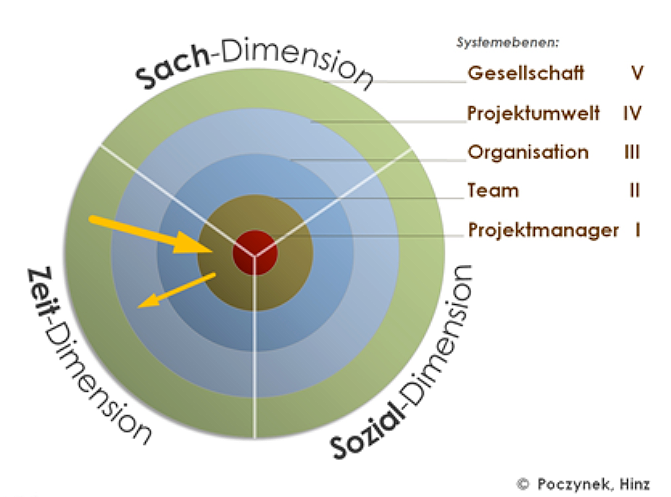Effective project leadership does not need heroes!
Have you ever seen a project captain celebrated and praised for steering the ship into port on time, within budget and to the agreed quality? No, those who survived storms, navigated around shoals and continued to sail at full speed with a leak are usually praised in the works meetings and weekly e-mails from the board of directors! And why is heroic effort almost always highly praised? Why are management heroes popular?
- Management heroes are popular because they organise, get things done and finish where others would not have done in a long time. In doing so, they often compensate personally for issues that are not sensibly organised in the structure of the company itself. They sacrifice themselves for the good of the project task at an unregulated interface between departments by building the bridge between these departments through tremendous personal commitment. But the gulf between the departments remains!
- They try to secure themselves directly through personal communication everywhere and then do almost everything themselves, instead of focusing on the lack of (budget) authority, (employee) responsibility and (top) management access.
- They reinvent the wheel instead of revealing non-functional processes, roles and tools.
For me it is clear why project heroes are popular with the management. They make sure that everything runs smoothly despite all this!
Heroes are driven
It is fascinating to observe how demotivating topics attract the management heroes like moths to a flame.
Planned economy instead of leadership
When plans become reality and decisions, once made, cement themselves as the only truth, even though the basic data have long since changed, then the if-then pattern prevails. Project captains experience this when their first, cautious outlook on the achievement of objectives is already entered into controlling as a secure project result at the kick-off meeting.
Management heroes feel committed to the linear thinking model and do everything possible to ensure that the “promise of success” from the kick-off is also fulfilled – in many cases unfortunately also according to the motto “whatever the cost”. Yellow or red traffic lights in reporting are always a reason for them to wipe the slate clean and almost never the time for a “realism” discussion with the client. They hide the fact that project management means making the undecidable decisions and using change requests and claim management as self-evident components. Because plans could also execute machines!
So as not to be misunderstood: I am not against structured project management and the corresponding tools and methods. But against their naive and mechanistic application. Large projects cannot be carried out effectively without project management software, because the necessary overview would no longer be achievable. My advice is to use planning tools and checklists for what they are: methods of support.
Motivation as heroic deed
“You are the project manager, then get the project team motivated,” is a phrase the management heros like to hear from the client. Now the core of heroism is addressed: that only I can achieve it and that it only depends on me. And so a seductive picture emerges in the mind’s eye of the project captain: if I use the right address or motivation method and successful psychological tricks, then the team motivation will succeed naturally.
Such a view on the subject of motivation is grandiose, certainly brave, but not wise.
Copy and Paste
Historical concepts of hierarchical, person-centred leadership are still being transferred to the project context. The adherents of this character theory (so-called Great Man Theory) rely heavily on individual abilities as determining factors of leadership competence. It is above all the stable character traits that distinguish good from bad managers. The following are frequently mentioned:
- sense of duty,
- liability,
- emotional stability,
- a strong competitive and target orientation
- as well as a self-confident, sometimes dominant appearance.
So if my character and my (innate) qualities are important, this supports the self-image as a management hero, because one is born to be a hero.
But project leadership in today’s organisations is different from the leadership in the middle of the last century, from which the character theories originated! Growing complications, networking, insecurity and complexity require an experienced leadership behaviour and not an escape into old, egocentric patterns.
Departmental selfishness in the matrix
Departmental selfishness in the matrix describes the (exploitation) of the often occurring gap between line managers and project managers in matrix organisations. If the incentives in a company are primarily based on the departmental result or the contribution margin of the department, then project work is difficult. While the heads of divisions, departments and specialist teams concentrate primarily on their success in the line organisation, management heroes try to work on their assignment “across the organisation” in their projects.
Management heroes then enter the field when they accept the non-cooperation of central line managers as a given and try to compensate for this through personal commitment. A typical situation of departmental thinking is the question of the appropriate team. Here it is important to be careful when the same light sailors are always offered. Probably nobody can use them on land and they are therefore often pushed onto the project ship.
The heroism described here – of course with a dash of Hanseatic irony – thinks in old categories of the linear model. But project management is a social process in which opposing interests and group dynamics are to be expected. Steering the project ship does not even mean setting and maintaining a course, but “that there is still something following”, because feedback and the unforeseen are the daily business of a project manager.
Heroism is no answer to dynamics and complexity
In the face of increasing complexity and dynamics, project heroes show an attitude that ignores the complexity of the task and instead counter this with a heroism that unfortunately too often ends in the proverbial heroic death.
Experienced seadogs have known it for a long time: Projects are usually not only assigned technically as development, reengineering or innovation projects, but often linked to change objectives as “change projects”. By definition, they devote themselves to complex, novel projects and materials and work on several levels simultaneously. This is not only about the factually and technically correct project object, but also about changing processes, cooperation, working environment and often also about costs, revenues, customers, markets and strategy.
The changes in internal and external complexity are multiplying more and more frequently in such a way that small and large waves can build up in front of our project ship to form a monster wave. Because projects explore the new and open a window to what is being done, thought or tried out outside the company.
Especially when the complexity of the project environment increases, it can quickly lead to excessive demands and failure. This is all the more true the less a clean environment analysis and clarification of expectations regarding the dynamics is made in the phase of project initiation and definition.Many projects fail because companies “stumble” into the internal and external complexity and take full advantage of the invitation to overload contained therein. The frequently heard request to start quickly and then “agilely” see what happens is an invitation for the doer qualities of a typical project hero.
This coincides with my observations of many sailing trips of leisure captains, who on a beautiful day in flip-flops quickly charter a boat without looking at the weather forecast, the sailing area or the nautical knowledge of the crew.
The alternative is nautical composure
So let us open a new view on the activity of project management: to steer a new type of activity with an entrepreneurial perspective in such a way that the project ship remains navigable! Successful project management begins long before the kick-off. Instead of forging elaborate plans, successful project managers go out into the organisation with nautical composure and secure your project directly and personally. Awake and ready to cooperate, they form coalitions of the willing, juggle different interests and actively take care of the ongoing changes in the project.
Effective project captains remain on the bridge when the wave of complexity rolls in ambiguous situations. This is where actionist heroes are not needed, but leadership and decision-makers who do not fall back on the checklist category of “right”/”wrong”, but rather decide what has been undecided so far at risk. The engine room alone can do the job or will do it. Calm captains keep calm in the difficult situation, radiate it and thus stabilise the situation.
Those who act in such a way take leave of heroism and need planning tools and checklists only for what they are: methods of support. Decisive for him are the behaviour as a calm project captain and the will to lead the people in the project. Maintaining composure is also easier for those who recognise that those responsible for changes in the plan are not to be blamed for deviations. Instead, they provide new and important information about what is changing outside. And finally, it helps to maintain the necessary maritime composure: Of course, it would be perfect for achieving the goal if one reacted 100% correctly to the new. However, such a reaction usually requires so much information that this “right” reaction would often come too late – and would therefore no longer be correct. It thus makes business sense for project captains to prefer the effective and sensible solution to the perfect one in unexpected situations.
Notes:
Olaf Hinz has published additional articles in the t2informatik Blog:

Olaf Hinz
For almost 20 years, Olaf Hinz has been guiding managers, project managers and organisations in transition through troubled waters. He believes that resistance is a powerful signal, change is the rule, and sailing in sight is the appropriate response to the approaching VUCA weather. As a non-fiction author and speaker, the self-confessed Hanseatic citizen and former office manager of Peer Steinbrück is a sought-after source of inspiration at specialist conferences and bar camps.



